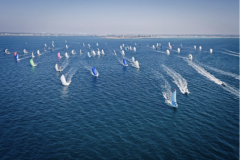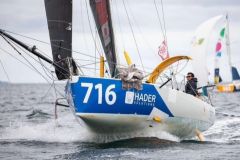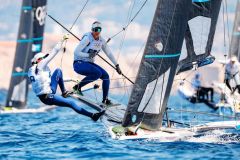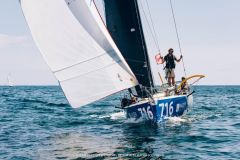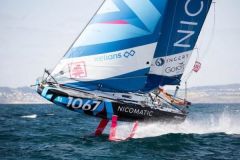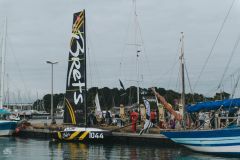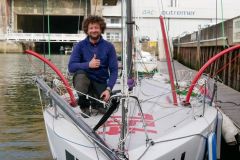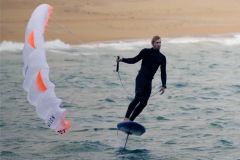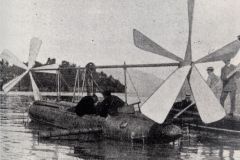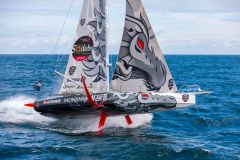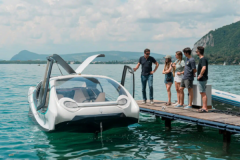Arkema 3 has just been launched. This mini deckchair designed by Romaric Neyhousser innovates in many fields. Built by Lalou Roucayrol's team, this prototype is already innovating in use - a first! - a fully recyclable resin ( see our topic on the explanation of this composite ).
But this boat also brings a lot of architectural innovations.
It uses the principle of the Scow hull, with a rounded bow, which we know today the interest it provides in terms of power and speed. "Having access to the foils made us think a lot about the choice of this hull. Did you have to add it all up? The overpowering of the hull and the one caused by the foils? At first we weren't really convinced," says Romaric Neyhousser. "But when we designed the hull, it became clear that a round bow would be the best solution: we became aware of the problems of hull misalignment that these boats have, which have unprecedented width/length ratios
As on all Mini prototypes, the keel is pendulum to increase the return torque.

A flexible wing as rigging
The Mini 6.50 Arkema 3 is equipped with a thick two-piece fabric sail, similar to the wings of C Class or America's Cup yachts, but not rigid. Contrary to the boats sailing in the bay, it was necessary to be able to reduce the sail on the Mini 6.50 (reef and lower the sail completely). The system must be reliable and manageable by a solo skipper in ocean conditions.
Romaric Neyhousser: "We designed a wing with two elements: a front element, around the mast, and a rear element. The second is articulated on the first with a rotation axis offset in front of the fall to create a gap, a slot, between the two elements. The difficulty lay in being able to stretch the fabric. We have set up a system with profiles that make it possible to obtain this "look" of a thick wing. Carbon shapes, which slide down the mast, give the wing a lower and upper surface."
César Dohy, master sailmaker at Incidence Sails, explains: "The wing covering was made from soft materials so that the sailor could vary the height of the sail. We used a conventional fabric because we were blocked by the gauge that only allows polyester".
The whole assembly is therefore hinged around the mast, which is not visible once the sail is hoisted. Recessed between the bottom of the hull and the deck of the boat, the mast is partially self-supporting without shrouds to hold it in place. Only a forestay to carry the headsail and runners are used to stabilize it.
"The gap between the two wing elements increases the lift coefficients and delays the stall angles", says Lalou Roucayrol. "On paper, this concept is potentially very interesting, but we remain cautious. It's a first on this type of boat. We'll have to wait for the first navigations to start getting some answers. The wing itself is a prototype, it will undoubtedly need further development after these initial tests."
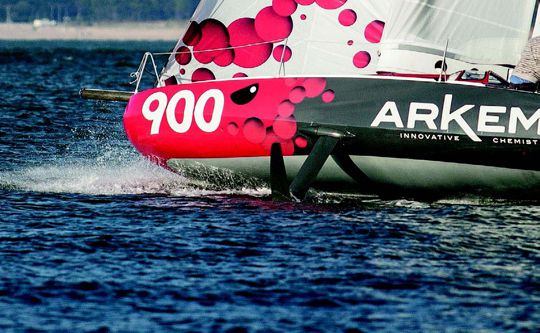
Adjustable foils
The Mini class gauge has evolved to allow the use of foils. In the previous gauge, the width of the boats, during the race, should not exceed 3 metres, including appendages. So there's no question of deploying foils wider than the boat. Before Arkema 3 was launched, only one boat (Simon Koster's No. 888) was fitted with foils, which extend inwards under the hull to comply with the maximum authorized width, an option that has not yet yielded any convincing results.
The new gauge maintains this 3-metre limit at the port and at the start of races. But according to the text, "the appendages can increase the width by 3 meters once the start is made but not more than 6.50 meters in the worst configuration." From now on, the skippers can retract the foil at the start and then deploy it as soon as the line is crossed. Seen from afar, the foils of the Mini look like those of the IMOCA boats (the 60-foot Vendée Globe boats). They are made up of two parts: a shaft (straight part that retracts into the shaft) and a tip (a kind of fin perpendicular to the shaft).
In IMOCA, the skippers can only retract or deploy the foil while sailing. On the other hand, the gauge, which is restrictive, prohibits any other dynamic adjustment, such as the incidence of the tip. In the Mini class, the gauge is more open and there are no restrictions on the settings: "We felt that we should not remain within the compromise defined by the IMOCA class, in order to benefit from greater versatility," emphasised Romaric Neyhousser. For example, Arkema 3's foils are mounted on an olive and can pivot to change their incidence, just like the keel.
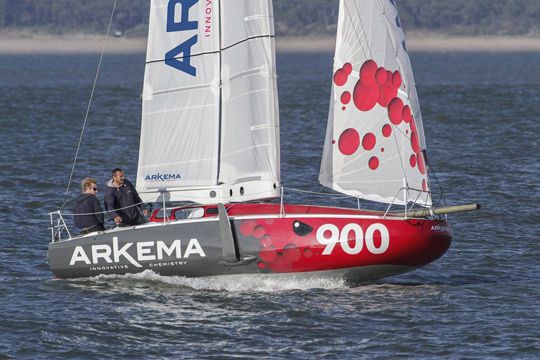
A pivoting forestay and a retractable bowsprit
Usually, on Mini 6.50, there is a forestay with the base fixed to the deck at the bow. At the base of this fixed forestay is a bowsprit which folds to the side of the boat when not in use, upwind for example.
But on Arkema 3, the width of the round bow allows for a different installation. The forestay is attached to a rail. Thus, it slides sideways on a trolley. The bowsprit connected to this trolley swivels with the forestay. Lalou Roucayrol explains the principle: "Manoeuvring the forestay to port or starboard also enables the bowsprit to be angled. You can send the headsail upwind (upwind forestay) - or leeward in some configurations."

A development that may be laborious
Now it's up to skipper Quentin Vlamynck to take charge of his boat. And this is not going to be an easy task, as the architect Romaric Neyhousser points out: "It should be noted that the multiplicity of innovations in the Mini 6.50 Arkema 3 does not make it easy for the skipper to get used to it. There are a lot of parameters to take into account and rigour will have to be required to move the boat forward, particularly in data acquisition, but one thing is certain: our approach has been exciting."
I'm looking forward to the first feedback from the boats and the first race confrontations to see if this floating laboratory is as promising as we'd like it to be.
Arkema 3
- Mini 6.50
- Architect: Romaric Neyhousser
- Year of construction: 2016
- Hull length: 6.50 m
- Hull width: 3.00 m
- Waterline length: 5.60 m
- Type of appendage: pendulum keel and foils
- Sandwich material: carbon Elium
- Draft : 2.00 m
- Sail downwind: 107 m²
- Upwind sails: 44 m²
- Air draught: 11.40 m
- Type of rigging: self-supporting wing mast
- Ballast: 350 kg
- Lightweight displacement: 800 kg






